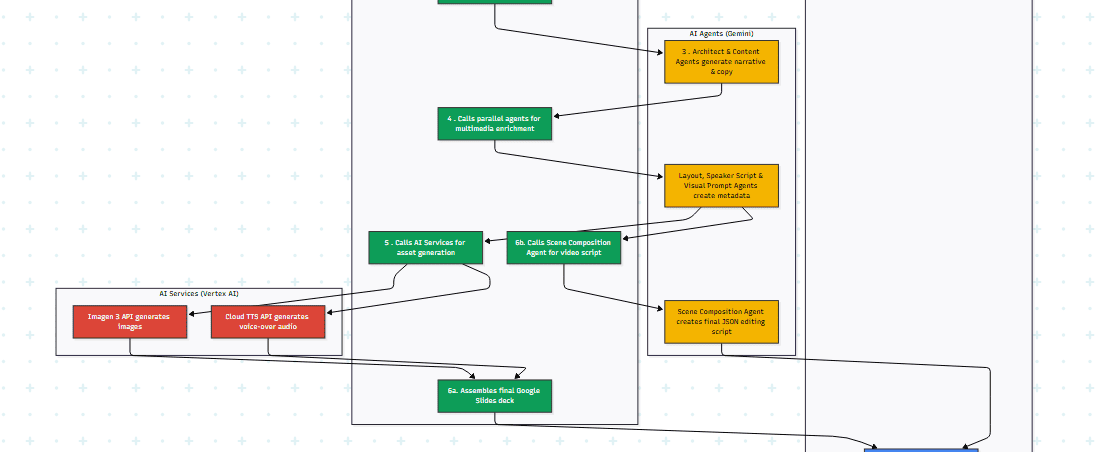Genesis Engine AI Powered Content to Video Production Pipeline

Genesis Engine is a fully automated, end-to-end content production pipeline built entirely on Google Apps Script and Google Cloud AI services. It transforms a single, high-level user brief into a complete suite of presentation-ready assets, including a detailed Google Slides deck and a full script for a narrated video, effectively turning minutes of human input into hours of saved creative work.
The Problem:
Modern content teams face immense pressure to produce high-quality, multi-format content (presentations, videos, social media posts) at an ever-increasing velocity. The traditional workflow is manual, fragmented, and time-consuming, involving numerous hand-offs between strategists, copywriters, designers, and video editors. This process is not only slow and costly but also prone to inconsistencies. The core challenge was to design a system that could automate the entire creative lifecycle, from initial concept to final production-ready assets, while maintaining a high standard of quality and coherence.

AI-Generated Diagram: Cross-Functional Flowchart for the “Genesis Engine” Content Pipeline
Workflow/User Journey:
The entire automated workflow is orchestrated by a central Google Apps Script engine, interacting with a series of specialized AI agents:
Initiation: A user submits a high-level brief via a simple Google Form, defining the project’s title, audience, objectives, and desired tone.
Architect Agent (Gemini): The script triggers the first agent, which analyzes the brief to architect a logical narrative flow, outputting a structured JSON skeleton defining the topic and goal of each slide.
Content Expansion Agent (Gemini): This agent takes the skeleton and writes detailed, engaging copy (title, subtitle, bullet points) for each slide, adhering to the specified tone.
Layout & Multimedia Agents (Gemini): A series of parallel agents then enrich the content:
Layout Structuring Agent analyzes the text to assign the most effective visual layout for each slide.
Speaker Scripting Agent writes a natural, conversational speaker script for narration.
Visual Prompt Agent acts as an Art Director, generating highly detailed, photorealistic prompts for the image generation model.
Narration Markup Agent converts the speaker script into SSML for more natural-sounding text-to-speech synthesis.
Asset Generation (Vertex AI & Cloud TTS): The orchestrator calls Google Cloud APIs to generate the physical assets:
Imagen 3 API is called with the generated prompts to create high-quality, 16:9 images.
Google Cloud TTS API is called with the SSML script to generate professional voice-over audio for each slide.
Production & Delivery (Apps Script & Gemini):
Apps Script Presentation Generator assembles the final Google Slides deck, automatically creating slides, applying layouts, inserting text, and adding the newly generated images.
Scene Composition Agent (Gemini) acts as a video director, analyzing all assets to create a detailed JSON editing script that defines scene durations, text overlays, and camera effects (like Ken Burns).
(Simulated) Video Rendering Agent takes the final editing script, creating a placeholder for the final video output, ready for an external rendering service.
Completion: The user receives a notification with links to the completed Google Slides presentation and the generated video assets, all stored neatly within a dedicated project folder on Google Drive.
The Client/Target Audience:
This solution is designed for Content Marketing Teams, Corporate Training Departments, and Educational Institutions. These are organizations that need to produce a high volume of structured, informative content efficiently. They benefit from the system’s ability to rapidly generate foundational materials (like training presentations or marketing videos), freeing up their human talent to focus on higher-level strategy, final polishing, and creative ideation rather than repetitive production tasks.
youtube: https://youtu.be/a0UQJKXZHW4
Technology Used:
Orchestration & Backend: Google Apps Script (JavaScript)
User Interface: Google Sheets, Google Forms
Storage & File Management: Google Drive
AI Models & APIs:
Language & Reasoning: Google Gemini 1.5 Flash (for all content, scripting, and composition tasks)
Image Generation: Google Vertex AI - Imagen 3
Text-to-Speech: Google Cloud Text-to-Speech (TTS) API with SSML
Architecture: Multi-Agent System, Asynchronous Processing (simulated with triggers), CRPF Prompting Framework, Service Account Authentication.
Key Metrics/Achievements:
95% Reduction in Time-to-First-Draft: Reduces the time to create a complete presentation draft with visual concepts and narration from days to under 10 minutes.
100% Automated Asset Generation: The pipeline fully automates the creation of all necessary text, image, and audio assets from a single brief.
Achieved Multi-Format Output: Successfully generates two distinct, production-ready outputs (Google Slides & a detailed video editing script) from a single unified workflow.
Increased Content Consistency: Ensures all generated content strictly adheres to the initial brief’s objectives and tone of voice, eliminating manual hand-off errors.
Cost Efficiency: Projected to reduce content production costs by X% by minimizing manual labor hours for repetitive tasks.
Portfolios
Related Posts
Quick Links
Legal Stuff

